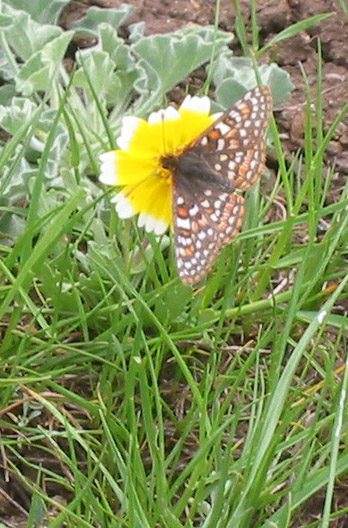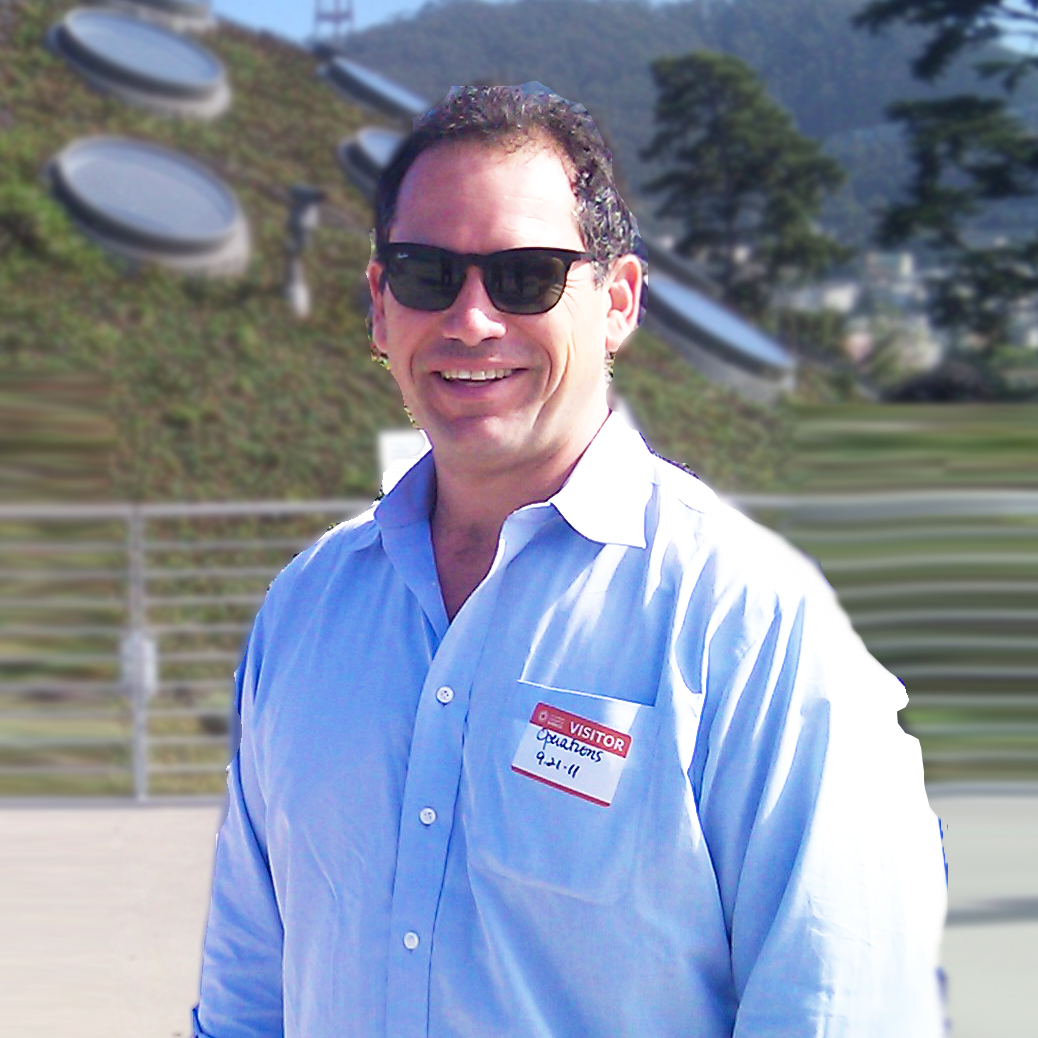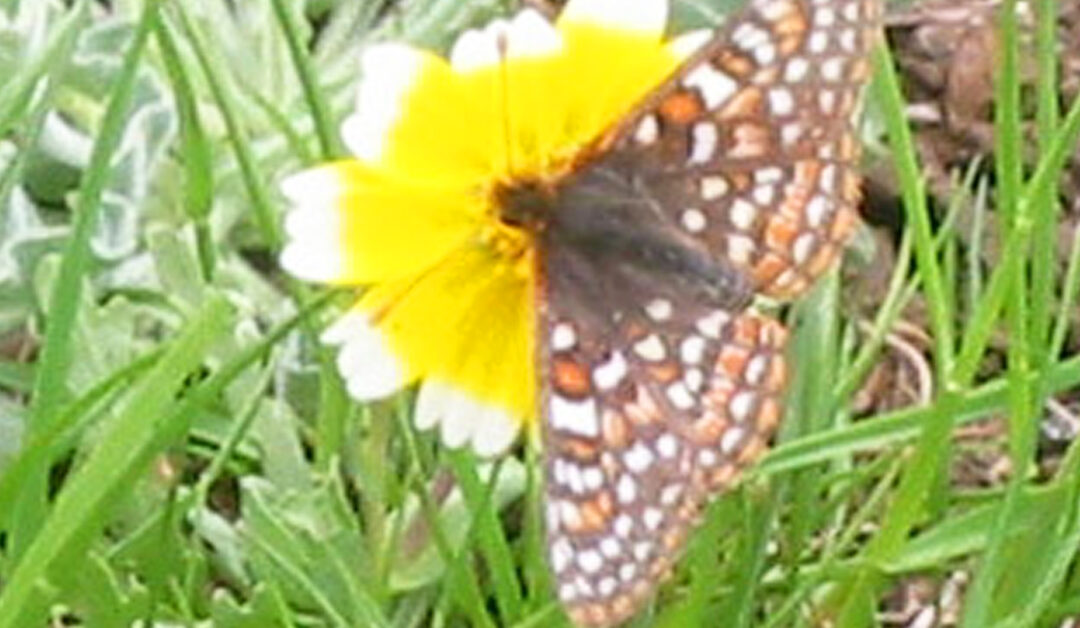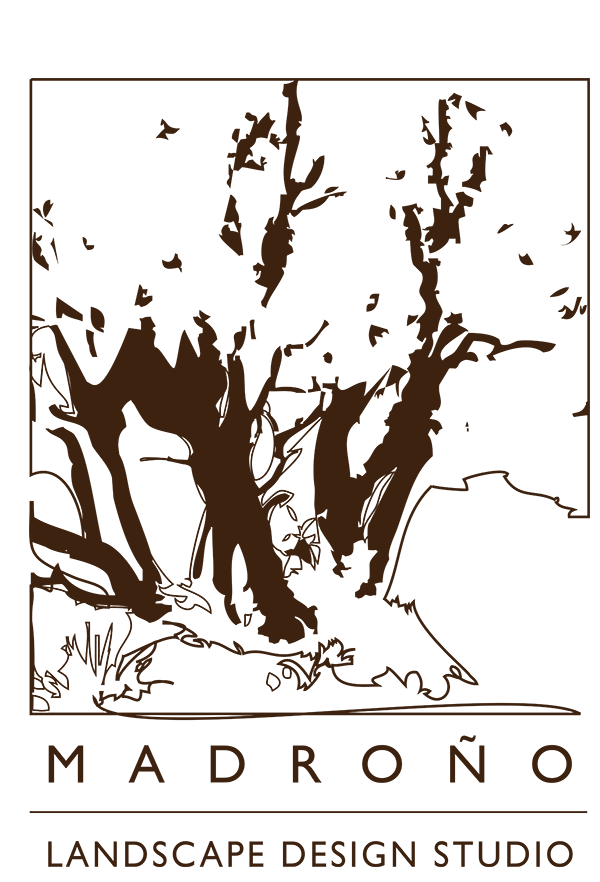Shifting identities and strange alliances occur along the wildland-urban interface, where natural ecosystems collide with cities and the side effects of human industry. Plants and animals living along these intersections must adapt to changing conditions, or perish. We now raise the curtain on a drama where cows protect rare and endangered butterflies from certain death by automobile, with a dramatis personae of native wildflowers and exotic grasses playing supporting roles.
Coyote Ridge, a large serpentine grassland two miles wide and fifteen miles long, lies just south of San Jose along Hwy 101. Serpentinite is the California state rock; this bluish-green stone was formed in darkness near the center of the earth, heated to a high boil and bubbled up through surface fractures (in this case the San Andreas Fault) to the open light. Most plants cannot grow on serpentine soil — not enough nitrogen, too much magnesium — but a select group of natives evolved in tandem with this infertile habitat, and they can survive it. Such an inhospitable medium also holds off the weedy European annual grasses that have so transformed the rest of our state. The beauty of the serpentine grassland therefore derives not just from its dazzling burlesque of April wildflowers, but because it shows what California looked like 300 years ago, when native grasslands embraced a third of the state; today they cover less than 1%.
Where did all the California grasslands go? First they were over-grazed by cattle, starting with the Spanish in the late 18th century and then again during the Gold Rush, when a million head of beef were shipped west to feed hungry miners. Many surviving grasslands were soon plowed under for agriculture and paved over for development. Those few remaining then suffered from poor fire management policy, where “wildfire suppression” was the only rule — as opposed to the practice of Native Americans, who understood fire’s regenerative power and set “controlled burns” in the grasslands for thousands of years. The final blow was the arrival of European annual grasses better adapted to the above conditions, growing taller and more quickly than the native bunchgrasses, self-seeding so prodigiously as to choke out any competition.
Right now the 7000 acres of Coyote Ridge are awash in shimmering colors: rolling yellow carpets of tidy tips and goldfields, bright swaths of purple owl’s clover and red jeweled onion, a vision of nodding white fairy lanterns and blue spikes of western larkspur, an exaltation of cream- and buttercups. Hairy black and yellow Bay checkerspot caterpillars gorge themselves on the low silvery foliage of dwarf plantain, and adult Bay checkerspot butterflies tipple nectar from tidy tips and wild onions. The proverbial birds and bees visit other wildflowers in promiscuous plenty, performing their sexual duties. The web of biodiversity here includes more than 100 plant species, with an average of 20 species occurring per half-meter-squared (approximately the area you can fit your arms around); this richness of flora in turn supports countless populations of tiny creatures that creep, scurry, burrow, and fly.

The California Native Plant Society (CNPS) reports that Coyote Ridge hosts 14 rare or endangered plant species. Favorites include the Tiburon paintbrush (Castilleja affinis ssp. neglecta), an elusive serpentine lover and Bay Area endemic with a yellow to pale-peach bloom; the Santa Clara Valley dudleya (Dudleya setchellii), whose succulent rosettes cling to rocky outcrops and produce subtle golden blossoms; and the most beautiful jewelflower (Streptanthus albidus ssp. peramoenus), an exquisite annual with robust purple flower spikes whose (un)common name says it all.
Cue the organ music: Coyote Ridge is adjacent to San Jose, a major source of air pollution. From the summit of the ridge, the nearby city is hardly visible through the hazy smudge. This smog, composed of nitrogen (N) and other less-savory ingredients like ozone and carbon monoxide, accumulates on parked cars and downtown storefront windows in a thin brown layer of dust; it also floats in the air into surrounding regions and settles onto the land. Let us recall that most plants need N to prosper; it is the lack of N in serpentine soils that keeps out the exotic invasive weeds and preserves the indigenous grasslands.
Enter the smog, stage left. Recent studies by local conservation ecologist Stu Weiss (among others) have revealed that urban air pollution in the Bay Area sends “dry deposits” of N molecules into the soil of adjacent wildlands at the annual rate of approximately 20 pounds per acre, the equivalent of spreading 5 large bags of concentrated industrial lawn fertilizer per acre per year via the tailpipes of our cars. This sobering statistic spells good times ahead for weedy annual grasses like wild oats (Avena fatua), soft chess (Bromus hordaceous), and Italian ryegrass (Lolium multiflorum), the most prolific of all exotic invaders of serpentine. Italian ryegrass, especially, dominates when enabled by N deposition and left to grow unchecked. It grows taller and faster than the low native grasses and forbs, shading them out and killing them. No low-growing natives means no Plantago erecta and no Castilleja exserta, the caterpillar food plants of the federally protected Bay checkerspot butterfly. No food means no more caterpillars, and that means no more butterflies.
Enter the cows, stage right. Coyote Ridge is privately owned by Castle & Cook, a national real estate development concern. Prevented from building here by San Jose’s Greenline ordinance limiting urban sprawl, C&C instead leases the land to a cattle rancher, who uses it for pasture. Cows wander among the butterflies and eat Italian ryegrass — when given the choice between it and any native bunchgrass, the cows go Italian every time. What accounts for taste? Something in the tiny bovine brain learns that the Italian ryegrass is high in N, which of course is healthy for the cow. By eating the exotic weeds, the cow gives a Darwinistic boost to the low-growing (and low-N) native plants, which in turn sustain the endangered butterflies.
Weiss says that dry N deposition is one of the most serious (if widely unrecognized) challenges facing the future of conservation ecology, and he underscores the need for a moderate grazing policy in contemporary grassland management, especially on serpentine soils near urban centers. He points to a barbed wire fence on the western edge of Coyote Ridge. On one side of the fence, where cows have been, the mosaic of native grasses and wildflowers tells a stirring tale of the interconnected diversity of life; on the other side, a dense sward of Italian ryegrass stretches into the distance. Weiss asks with an ironic grin, “Which ecosystem would you prefer?”
Formerly a villain in the tragedy of California’s devastated grasslands, the humble cow now takes her place as hero, a leading lady. But the dastardly automobile still growls from offstage, the ominous Iago in cahoots with marauding Italians. Rare and historic plant populations are invested in the drama. Whether or not the endangered butterfly will live to see the curtain call, only time will tell.
* * *
Geoffrey Coffey also prefers to eat Italian. He is the founder of the Madrono landscape design studio, a princpal of Bay Natives nursery, and a freelance writer for the San Francisco Chronicle.

Madroño president Geoffrey Coffey started the company in 2005 out of the back of a pickup truck. His garden column, “Locals Only”, first appeared in the San Francisco Chronicle in 2002. He lives in San Francisco with his wife and two children, where he also sings and thumps the bass for Rare Device.


